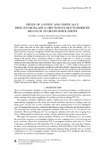Mostrar o rexistro simple do ítem
Study of a static and vertically free-to-oscillate 4:1 rectangular cylinder by means of 2D URANS simulations
| dc.contributor.author | Álvarez Naveira, Antonio José | |
| dc.contributor.author | Nieto Mouronte, Félix | |
| dc.contributor.author | Hernández, Santiago | |
| dc.date.accessioned | 2021-04-15T18:54:23Z | |
| dc.date.available | 2021-04-15T18:54:23Z | |
| dc.date.issued | 2018 | |
| dc.identifier.citation | A.J. Álvarez, F. Nieto, S. Hernández (2018). Study of a static and vertically free- to-oscillate 4:1 rectangular cylinder by means of 2D URANS simulations. WIT Transactions on Engineering Sciences, 2018, vol. 120, p. 41-50. | es_ES |
| dc.identifier.issn | 1743-3533 | |
| dc.identifier.uri | http://hdl.handle.net/2183/27760 | |
| dc.description.abstract | [Abstract:] Flexible structures, such as cable-supported bridges, are prone to suffer from vortex-induced vibrations (VIV) under wind flow, as their span lengths are steadily growing in the last decades. VIV is a phenomenon that takes place at reduced wind speeds. The movements of the structure at VIV are self-limited and their frequency corresponds with the natural frequency of the structure (lock in). Therefore, VIV affects the structure’s serviceability and can cause fatigue related damage. Hence, the need for identifying and avoiding this phenomenon at the early design stages is a key issue in long-span bridges design. In the present study a rectangular cylinder of width to depth ratio 4:1, which is a common simplification of a bridge deck cross section, is analysed for the static case as well as undergoing free vibration in the vertical direction under wind flow. These analyses have been carried out by 2D URANS CFD simulations, adopting two different turbulence models: the k − ω SST, which is based upon the Boussinesq eddy-viscosity approximation, and the Reynolds Stress Model, which directly calculates the components of the specific Reynolds stresses. For the static case the force coefficients, Strouhal number and the pressure coefficient distributions were calculated and compared with the available experimental data. In the case of the free-to-oscillate 4:1 rectangular cylinder, the oscillation amplitudes are compared with wind tunnel data reported in the literature. In addition, the frequencies and phase-lags between the time-dependent lift coefficient and the vertical oscillations are studied. | es_ES |
| dc.description.sponsorship | Ministerio de Economía y Competitividad; BIA2016-76656-R | es_ES |
| dc.description.sponsorship | Ministerio de Economía y Competitividad; BES-2014-068418 | es_ES |
| dc.description.sponsorship | Ministerio de Economía y Competitividad; BIA2013-41965-P | es_ES |
| dc.description.sponsorship | Xunta de Galicia; ED431C 2017/72 | es_ES |
| dc.language.iso | eng | es_ES |
| dc.publisher | WIT Press | es_ES |
| dc.relation.uri | https://doi.org/10.2495/AFM180051 | es_ES |
| dc.rights | Copyright: WIT Press | es_ES |
| dc.subject | 4:1 rectangular cylinder | es_ES |
| dc.subject | Vortex shedding | es_ES |
| dc.subject | Vortex-induced vibrations | es_ES |
| dc.subject | Force coefficients | es_ES |
| dc.subject | URANS | es_ES |
| dc.subject | Reynolds Stress Model | es_ES |
| dc.subject | CFD | es_ES |
| dc.subject | Pressure distribution | es_ES |
| dc.title | Study of a static and vertically free-to-oscillate 4:1 rectangular cylinder by means of 2D URANS simulations | es_ES |
| dc.type | info:eu-repo/semantics/conferenceObject | es_ES |
| dc.rights.access | info:eu-repo/semantics/openAccess | es_ES |
| UDC.journalTitle | WIT Transactions on Engineering Sciences | es_ES |
| UDC.volume | 120 | es_ES |
| UDC.startPage | 41 | es_ES |
| UDC.endPage | 50 | es_ES |
| dc.identifier.doi | 10.2495/AFM180051 | |
| UDC.conferenceTitle | Advances in Fluid Mechanics XII | es_ES |






